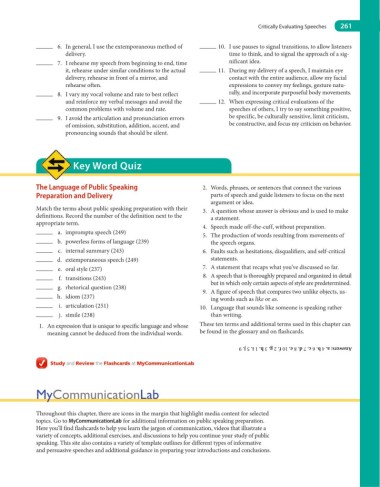Page 282 - Essentials of Human Communication
P. 282
Critically Evaluating Speeches 261
6. In general, I use the extemporaneous method of 10. I use pauses to signal transitions, to allow listeners
delivery. time to think, and to signal the approach of a sig-
7. I rehearse my speech from beginning to end, time nificant idea.
it, rehearse under similar conditions to the actual 11. During my delivery of a speech, I maintain eye
delivery, rehearse in front of a mirror, and contact with the entire audience, allow my facial
rehearse often. expressions to convey my feelings, gesture natu-
8. I vary my vocal volume and rate to best reflect rally, and incorporate purposeful body movements.
and reinforce my verbal messages and avoid the 12. When expressing critical evaluations of the
common problems with volume and rate. speeches of others, I try to say something positive,
9. I avoid the articulation and pronunciation errors be specific, be culturally sensitive, limit criticism,
of omission, substitution, addition, accent, and be constructive, and focus my criticism on behavior.
pronouncing sounds that should be silent.
key Word Quiz
the language of public speaking 2. Words, phrases, or sentences that connect the various
preparation and delivery parts of speech and guide listeners to focus on the next
argument or idea.
Match the terms about public speaking preparation with their 3. A question whose answer is obvious and is used to make
definitions. Record the number of the definition next to the a statement.
appropriate term. 4. Speech made off-the-cuff, without preparation.
a. impromptu speech (249) 5. The production of words resulting from movements of
b. powerless forms of language (239) the speech organs.
c. internal summary (243) 6. Faults such as hesitations, disqualifiers, and self-critical
d. extemporaneous speech (249) statements.
e. oral style (237) 7. A statement that recaps what you’ve discussed so far.
f. transitions (243) 8. A speech that is thoroughly prepared and organized in detail
but in which only certain aspects of style are predetermined.
g. rhetorical question (238) 9. A figure of speech that compares two unlike objects, us-
h. idiom (237) ing words such as like or as.
i. articulation (251) 10. Language that sounds like someone is speaking rather
j. simile (238) than writing.
1. An expression that is unique to specific language and whose These ten terms and additional terms used in this chapter can
meaning cannot be deduced from the individual words. be found in the glossary and on flashcards.
Study and Review the Flashcards at MyCommunicationLab Answers: a. 4 b. 6 c. 7 d. 8 e. 10 f. 2 g. 3 h. 1 i. 5 j. 9
MyCommunicationLab
Throughout this chapter, there are icons in the margin that highlight media content for selected
topics. Go to MyCommunicationlab for additional information on public speaking preparation.
Here you’ll find flashcards to help you learn the jargon of communication, videos that illustrate a
variety of concepts, additional exercises, and discussions to help you continue your study of public
speaking. This site also contains a variety of template outlines for different types of informative
and persuasive speeches and additional guidance in preparing your introductions and conclusions.

